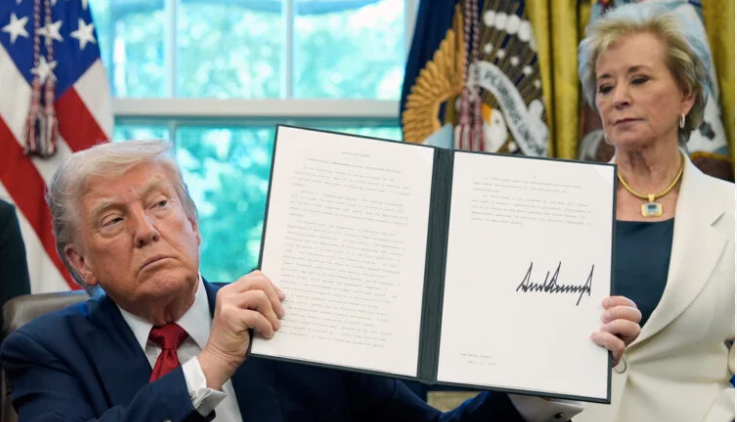

Restoring Order: Trump’s Push for Accountability in K-12 Discipline
At an Oval Office event on April 23, President Trump announced a set of executive orders “promising a more conservative approach to K-12 instruction”. Trump and his aides framed the initiative as restoring “common sense” discipline: the White House statement explained its goal is to ensure schools’ “discipline policies are based on objective behavior, not DEI”. In other words, the new guidance would forbid considering a student’s race, gender or other group status when imposing consequences – focusing exclusively on the student’s actual misbehavior.
Key Proposals in Trump’s Plan
Trump’s announcement outlined several concrete changes to current federal discipline policy. Key elements include:
- Behavior-based guidance: The Education Secretary (working with the Attorney General) is to issue new guidance making clear that school discipline must focus solely on a student’s conduct. As the order puts it, discipline should be based “solely on students’ behavior and actions.” In practice, this means educators would treat identical misbehavior the same way for every child, without adjusting punishments based on race or other characteristics.
- Reversal of equity-driven rules: The proposal rescinds Obama/Biden-era policies aimed at reducing racial disparities in discipline. For example, Trump’s action formally withdraws the Biden administration’s guidance encouraging schools to analyze discipline data by race, and it prohibits any “racially preferential discipline practices”npr.org. In practical terms, a school could no longer moderate a suspension quota to reduce racial gaps. Instead, all misbehavior would be judged by a common standard.
- Model discipline policies: Within 120 days, the Education Department will publish model discipline codes “rooted in American values and traditional virtues”. These templates are intended to serve as examples of “commonsense” discipline policies that protect student safety. The emphasis on “traditional virtues” underscores personal responsibility and respect for authority as guiding principles.
- Enforcing Title VI: The plan emphasizes strict enforcement of the Civil Rights Act (Title VI) in school discipline. The Education Secretary is directed to issue guidance and to take action – including withholding federal funds – against any local district or state that fails to protect students from racial discrimination in disciplinewhitehouse.gov. In practice, this means schools would be held accountable if they deliberately alter discipline outcomes by race.
- Cutting DEI funding: The executive order calls for an inventory of any federal grants or nonprofit programs that promote what it calls a “discriminatory-equity-ideology” in school discipline. It then recommends terminating funding for programs found to teach discipline practices based on group identity. In short, any organization receiving federal money that explicitly advises schools to consider race in discipline could lose its support.
- Military schools code: The Department of Defense must revise the discipline code for schools serving military families to align with the new federal guidance. This ensures that U.S. military-run schools follow the same behavior-based standards.
Together, these measures would dismantle current federal guidance aimed at equity in discipline. Trump’s team argues that previous “equity” policies forced schools to excuse misbehavior to avoid disparate impact, thereby making classrooms less safe. In Trump’s view, the new rules will close that gap and return accountability to the classroom.
Accountability-Based Discipline Focus
At its core, Trump’s agenda embodies accountability-based discipline – the idea that students should be held personally responsible and that rules be enforced uniformly. The emphasis is on what a student did, not who they are. This is clear in both the language and justification of the proposals. For example, Secretary of Education Linda McMahon praised the shift, saying, “A student’s success in adulthood starts with how they perform in a classroom, and we should teach our kids to discern right and wrong from a young age” – adding that “disciplinary decisions should be based solely on students’ behavior and actions”. Similarly, the White House repeatedly stresses that any notion of “equity” that alters penalties based on demographics must end.
Proponents of this approach argue it restores fairness and order. As one conservative education advocate put it, the new policy “empowers local school boards by encouraging real discipline” and frees “educators to focus on teaching, not chaos, ensuring kids get a quality education”. By ending federal mandates on racial outcomes, supporters say teachers and principals will be able to enforce rules consistently, reinforcing the idea that every student is accountable for misbehavior.
In practice, an accountability-based system treats a given infraction – say, a fight or a disruptive act – the same way for all students. It rejects practices like tying punishments to campus-wide racial statistics. Instead, the proposed “model policies” (due in 120 days) explicitly reject “unlawful discrimination” and promote common-sense consequenceswhitehouse.gov. Advocates liken this to traditional zero-tolerance or uniform discipline policies, but with an explicit stance against any identity-based considerations. (It does not outlaw restorative practices outright, but it bars any federally funded program that uses race-based exclusion when disciplining students.)
By contrast, restorative or progressive models typically focus on reconciliation and may adjust discipline to address systemic issues. Trump’s plan side-steps that debate: it treats each offense in isolation. As K-12 Dive notes, many schools had in recent years “shunned strict zero-tolerance” in favor of restorative approaches to keep students in class. Trump’s orders signal a return toward firmer enforcement. It is precisely an “accountability-first” philosophy – believing that order and safety come from equal enforcement of rules – even if data on racial disparities results.
Broader Context and Debate
The timing and content of Trump’s announcement come amid a renewed national debate over school discipline. Educators have reported a post-pandemic surge in disruptive behavioredweek.orgk12dive.com, and some state governments have responded by strengthening discipline laws. For instance, Florida, North Carolina and Texas have considered or passed measures giving teachers more authority to suspend or remove students for misconduct. These moves reflect growing concern among many parents and leaders that classrooms need stronger order.
At the same time, long-standing racial discipline gaps remain. Federal data show that Black students (15% of enrollment) account for far higher shares of suspensions and expulsions. The Biden administration’s May 2023 guidance asked districts to “examine the underlying causes” of such disparities and offered case studies of districts improving their practices. It did not impose quotas, but it marked a clear effort to keep disparities in focus. Trump’s proposal directly rejects that approach: it instructs districts not to consider such disparities at all in discipline decisions.
Civil rights and student advocacy groups have criticized this shift. They warn that removing equity considerations could “permit school discipline practices that target and punish students of color and students with disabilities at disproportionate rates”k12dive.com. Some fear the change could effectively revive a “school-to-prison pipeline” by increasing suspensions and expulsions, especially for minority or vulnerable students. To be sure, Trump’s plan does not explicitly forbid any discipline measure; it simply says race can’t be a factor. But critics argue that in practice this could magnify existing disparities.
On the other hand, many conservative education commentators see the proposals as correcting past mistakes. They argue that decades of trying to engineer discipline outcomes by race undermines teacher authority. In Trump’s telling, the Obama-era 2014 “Dear Colleague” letter actually forced teachers to ignore misbehavior to avoid disparities – hurting overall school safety. The new orders echo Trump’s first-term stance (he rescinded the 2014 guidance in 2018) and double down on the idea that discipline should be a matter of personal responsibility. For this reason, the plan is likely to draw strong support from parents and groups who have pushed for stricter discipline and back-to-basics education standards.
Trump’s April 2025 announcement makes clear that school discipline is back on the national policy agenda – framed in conservative terms as a matter of accountability and order. His proposals would reverse the recent emphasis on remedying racial disparities and instead codify uniform, behavior-based discipline rules. Supporters will see this as a welcome reaffirmation of teacher authority and equal treatment of students under the rules. Critics will see a risk of harsher outcomes for marginalized students. In either case, the initiative highlights a fundamental debate in K-12 education: should schools enforce the rules equally for all, or should they adjust discipline practices to address broader social inequities?
For a readership inclined toward school safety and traditional values, Trump’s plan signals a confident push toward the former. It frames discipline not as a liability or a symptom to be fixed with data, but as a building block of a proper education. The real-world impact will depend on how local districts respond and whether Congress or future administrations act on these ideas. But as a policy statement, it clearly casts discipline in K-12 classrooms as an accountability issue: every misdeed punished on its merits, no matter who committed it.
Dig Deeper With Our Longreads
Newsletter Sign up to get our best longform features, investigations, and thought-provoking essays, in your inbox every Sunday.
The MEN was founded by John Huber in the fall of 2020. It was founded to provide a platform for expert opinion and commentary on current issues that directly or indirectly affect education. All opinions are valued and accepted providing they are expressed in a professional manner. The Maryland Education Network consists of Blogs, Videos, and other interaction among the K-12 community.











